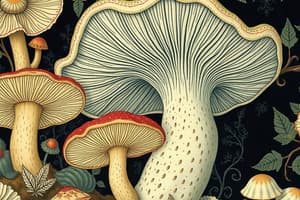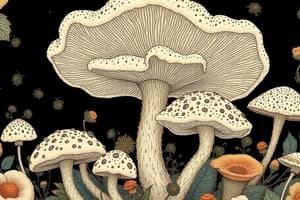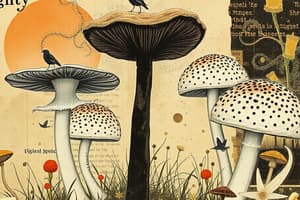Podcast
Questions and Answers
Are fungi heterotrophic or autotrophic?
Are fungi heterotrophic or autotrophic?
heterotrophic
How do fungi obtain nutrients?
How do fungi obtain nutrients?
By secreting digestive enzymes that break down organic matter and absorbing the decomposed molecules.
What do fungi usually form symbiotic relationships with?
What do fungi usually form symbiotic relationships with?
Plants, algae, and cyanobacterium.
What is the recognizable part of Amanita muscaria?
What is the recognizable part of Amanita muscaria?
What are some commercial uses for fungi?
What are some commercial uses for fungi?
Fungi are important to an ecosystem as what?
Fungi are important to an ecosystem as what?
How do fungi digest food?
How do fungi digest food?
How do fungi obtain energy?
How do fungi obtain energy?
How do fungi obtain food?
How do fungi obtain food?
Chitin is found in fungi and in what else?
Chitin is found in fungi and in what else?
Do fungi... A) contain chlorophyll? B) have cell walls made of chitin? C) produce their own food?
Do fungi... A) contain chlorophyll? B) have cell walls made of chitin? C) produce their own food?
What are hyphae?
What are hyphae?
A hypha is a long string of cells divided by what?
A hypha is a long string of cells divided by what?
What do mycorrhizae aid in?
What do mycorrhizae aid in?
Most fungal spores are formed by what process?
Most fungal spores are formed by what process?
Give some examples of club fungi:
Give some examples of club fungi:
Give some examples of fungus:
Give some examples of fungus:
What are sporangia?
What are sporangia?
Zygospores allow molds to do what?
Zygospores allow molds to do what?
The group of fungi that includes the molds that often grow on bread is the what?
The group of fungi that includes the molds that often grow on bread is the what?
What features characterize fungi?
What features characterize fungi?
What structure is responsible for meeting the food requirements for the mushroom?
What structure is responsible for meeting the food requirements for the mushroom?
What does a lichen consist of?
What does a lichen consist of?
Some mycorrhizae do not penetrate the host plant but rather wrap around the what?
Some mycorrhizae do not penetrate the host plant but rather wrap around the what?
When hyphae grow, they form a mass called a what?
When hyphae grow, they form a mass called a what?
Lichens are sensitive to __________ such as sulfur dioxide in the atmosphere.
Lichens are sensitive to __________ such as sulfur dioxide in the atmosphere.
Fungi obtain food by ___________ organic matter.
Fungi obtain food by ___________ organic matter.
Lichens are able to carry out ___________ fixation.
Lichens are able to carry out ___________ fixation.
The common name given to unicellular ascomycetes is what?
The common name given to unicellular ascomycetes is what?
What is an ascus?
What is an ascus?
Flashcards are hidden until you start studying
Study Notes
Fungi Overview
- Fungi are heterotrophic organisms, relying on other organisms for nutrition.
- They secrete digestive enzymes to decompose organic matter, absorbing the nutrients thereafter.
- Key symbiotic relationships typically occur with plants, algae, and cyanobacteria.
Characteristics and Structure
- Amanita muscaria is recognized for its deadly red cap.
- Fungi have filamentous bodies composed of hyphae, forming a mycelium.
- Hyphae are divided by septa, creating nonreproductive filaments crucial for nutrient absorption.
- Cell walls of fungi are made of chitin, distinct from plant cell walls made of cellulose.
Nutritional Mechanisms
- Fungi cannot photosynthesize; they do not contain chlorophyll and cannot produce food from sunlight as plants do.
- They depend on breaking down organic material to obtain energy for growth and function.
- Fungi absorb nutrients from the decayed organic matter outside their cells.
Ecology and Roles
- Fungi play a vital ecosystem role as decomposers, recycling nutrients from dead organisms.
- Mycorrhizae enhance the growth of commercially important trees and facilitate mineral transfer from soil to plants.
Reproduction and Spores
- Most fungal spores are formed through mitosis during asexual reproduction.
- Zygospores allow molds to remain dormant until favorable conditions arise.
- Examples of club fungi include mushrooms, toadstools, puffballs, jelly fungi, and shelf fungi.
Commercial Uses
- Yeasts are unicellular fungi used in baking, brewing, and winemaking.
- Certain fungi contribute to the flavor of various cheeses.
- Fungi, like Penicillium, are sources of important antibiotics.
Lichens
- Lichens consist of a symbiotic relationship between a fungus and a photosynthetic organism (green alga or cyanobacterium).
- They are sensitive indicators of air pollutants, including sulfur dioxide.
- Lichens can perform nitrogen fixation, which contributes to soil fertility.
Additional Facts
- Zygomycetes are molds that commonly grow on bread.
- Ascomycetes are another group of fungi that includes yeasts.
- Sporangia are structures where spores are produced, particularly in zygomycetes.
- The mycelium, composed of hyphae, fulfills the food requirements for mushrooms.
Studying That Suits You
Use AI to generate personalized quizzes and flashcards to suit your learning preferences.




